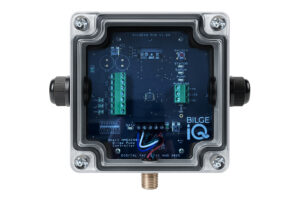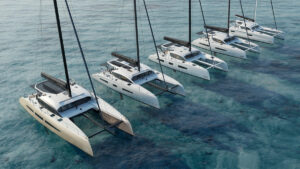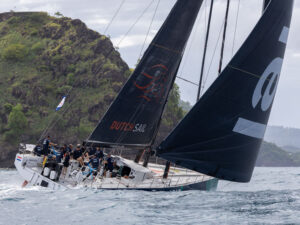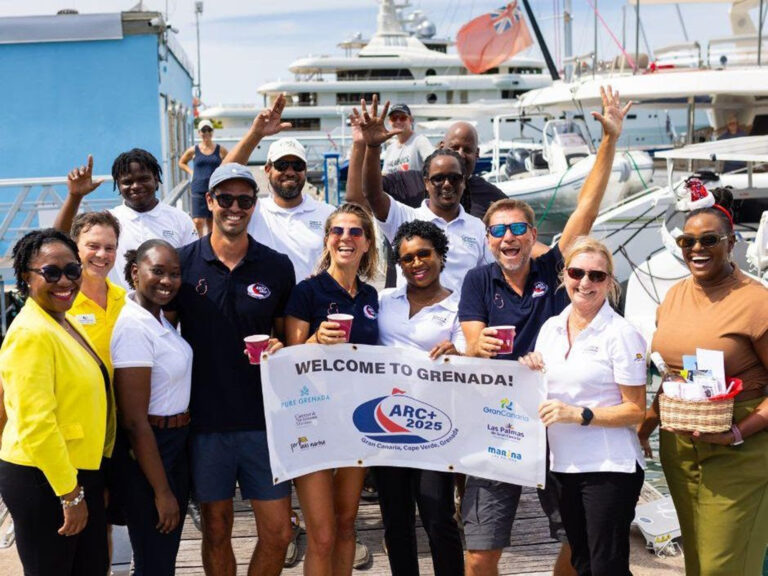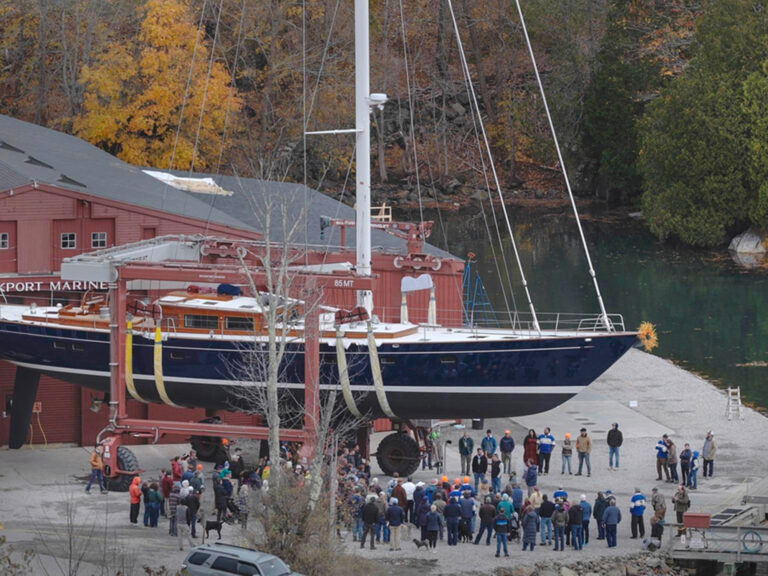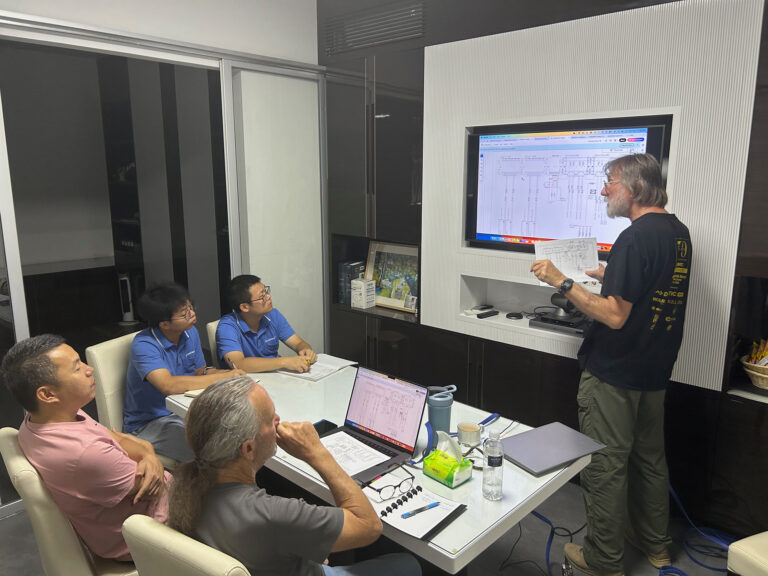
Sailing a boat with one of the yacht designers who created it is always an interesting experience, especially when he or she is doing so for the very first time. Such was the case last summer on the Severn River off Annapolis, Maryland, when Jim Schmicker, a senior naval architect at Farr Yacht Design—and a key member of the team responsible for the new Bavaria Cruiser line of sailboats ranging from 32 to 55 feet—stepped behind one of the twin wheels of the Cruiser 45.
As we motored up the river, noting the dual rudders employed in the 45, Schmicker said, “Under power, you don’t have that immediate flow of water over the rudder that you’d have with a single, conventional propeller-and-rudder configuration, so there’s not as much directional control.” That said, once the laminar flow was established, the yacht handled well under sail and power. At maneuvering speeds, the bow thruster later made for easy docking.
“And the twin rudders allow fuller sections forward,” Schmicker added, “and one of the driving forces on this model was accommodating the two double-cabin option in the bow, which resulted in a fullness in the upper topsides forward. A single rudder on this hull shape would be a disaster, as the beam is carried well aft. As designers, our job is to make the volume work accordingly so you still have a boat that sails well, with a lot of interior space and a big cockpit.” For the record, a single forward stateroom is also available.

_The Bavaria Cruiser 45 is laid out with twin wheels and dual rudders, which translate to exceptional handling and maneuverability, especially when sailing upwind. _
Moments later, after unfurling the standard stowaway Seldén main and 100-percent jib, despite the fact that the northwest breeze hovered around a mere 6 knots, Schmicker smiled as he feathered the boat assuredly to weather, and the knotmeter steadily ascended to almost 5 knots, an impressive figure given the light air. Clearly, as a designer, he was pleased with the overall result.
It’s a coincidence that both Farr Yacht Design and Bavaria USA—under the direction of a new management team including entrepreneur Kenny Feld; Andrew Thompson, who, along with Sylvia Driver, established a strong relationship with Bavaria in their ongoing roles as directors of Horizon Yacht Charters in the Caribbean; and industry veteran Geoff McCord, formerly of Beneteau USA—are both headquartered in Annapolis. Farr became involved with the high-volume German production builder several years ago as it was contemplating launching a new line.
Farr was first commissioned to design the Cruiser 55, followed by the 32-footer, and then the other four boats in the series (including the most recent design in the lineup, the Cruiser 50). In June, from the company’s handy docks at Yacht Haven, we sailed the first shipment of new imports: the Cruiser 32, 36, 40, and 45 (only the latter of which has twin rudders, though the 40 has dual wheels). Bavaria USA’s ambitious business plan calls for future bases in the Northeast, the Great Lakes region, and the West Coast. Owners may also elect to charter out their boats through Horizon, and even undertake seasonal migrations back and forth between Chesapeake Bay and the Caribbean, as Horizon is a sponsor of the Caribbean 1500 and Atlantic Cup.
While each respective model has its own distinctive features, there are numerous characteristics that are shared across the line. Thanks to the collaborative efforts between Farr and BMW Group DesignworksUSA—a subsidiary of the automotive BMW Group specializing in industrial design—there’s a distinctive look and feel to the entire Cruiser range, particularly with the low-profile coach roofs and recessed, integral dodger molds; the wide beams, carried well aft; the stem rakes; and the transom angles and treatments. All the boats are available with numerous wood options (combinations of mahogany, oak, and walnut) for the floors and joinery work, and there are 11 different upholstery fabrics from which to choose, providing a high degree of owner customization that is unusual in production boatbuilding.
“We’re responsible for all the naval architecture, the hull and structural design, the appendage design, rig sizing, and the basic concept of putting those things together,” said Schmicker. “We’re more technically marine oriented than Designworks. They use different tools and come at it from a styling side and an artistic side with respect to the interior, the accommodations, and the deck details that make it easy to get around the boat.” In addressing the final point, all the Cruisers are equipped with flush hatches, coachroof-mounted genoa leads (facilitated by nonoverlapping working headsails), aft-led running rigging, and wide spreader bases, which translate to easily negotiated side decks.
In addition, all have deck-stepped masts; generous, transom-wide drop-down swim/boarding platforms; and are offered in shoal- or deep-keel versions. Farr Yacht Design’s goal is creating stiff boats, and the internal policy, incorporated in the Cruiser line, is to never produce a yacht with an angle of vanishing stability that exceeds 115 degrees.
The Cruisers are all built to exacting Germanishcher Lloyd certification standards, with Coremat incorporated in the otherwise solid laminate in sections of the hull below the waterline as well as in the internal grid and some of the liners, and Airex PVC rigid foam core sandwiched in the deck and topsides. Remarkably, the time between placing a new order and taking delivery in Annapolis is under three months. “Standard” U.S. boats come with a long list of items, such as the aforementioned furling mainsail, showers in the heads, hot water, electric windlasses, and other features that are optional extras on yachts destined for European markets.
Finally, as we discovered during our tests of the boats—not surprisingly, considering Farr Yacht Design’s pedigree of highly successful inshore and offshore raceboats—they indeed sail very well.
We’ll work backward from the largest to the smallest: When sailing upwind with the boat slightly heeled, the dual rudders on the Cruiser 45 provided exceptional control. My favorite place to steer was outboard, to windward and leeward of the matching wheels, where the views of the jib telltales were clear and unobstructed. As with the other U.S. imports, the 45 was equipped with the standard shoal keel, though it didn’t seem to affect the pointing ability, as the angle between tacks was only about 75 degrees. Schmicker said that performance to windward wasn’t an issue with the shallower configuration, though it did have a small effect on boat speed in certain conditions.
“In general, shallow-draft keels will be a bit slower in light airs just because they have a little more displacement and a little bit more wetted surface, mostly through that displacement increase, to get the stability up where it needs to be,” he said.
The interior of the 45 we sailed didn’t include the double cabins in the bow but instead was laid out with a spacious forward stateroom with a private head and basin to starboard and a separate shower cubicle to port; the double cabins aft also have their own en suite heads and showers. Thanks to a 14-foot beam, the accommodations felt voluminous.
Like its bigger sister, the shoal version of the Cruiser 40 also has a wing keel (the 32 and 36 have ballast bulbs) and a pair of wheels, but they’re linked to a single rudder, and the response to small helm adjustments isn’t as immediate. Still, it’s a fine-sailing boat, and upwind, as the breeze freshened to around 10 knots, the boat registered over 6 knots of speed when hard on the breeze. And under power, at 2,800 rpm, the 38-horsepower Volvo Penta engine (with saildrive, like the four other boats in this round-up) knocked off a startling 8.4 knots.
The 40 has two accommodations plans: three double cabins, with two heads and showers, or two double cabins, with a single head/shower configuration. Each has a straight-line galley to port that opposes a wraparound, U-shaped settee and dining table to starboard, just forward of a good-sized navigation station. Proportionately, though it’s still a very comfortable cruising boat, the 40 doesn’t have the “XXL” feel of the 45.

__
Down below on the Bavaria Cruiser 40, the straight-line galley is to port. On all of the models, owners can choose from a variety of woods for the floors and furniture, and from 11 different upholstery options.
The same can’t be said of the Cruiser 36, where the expansive theme is repeated down below. There’s more than generous headroom throughout, even forward in the double cabin, which isn’t always the case in a 36-foot boat. Once again, there are two interior options, one with a pair of double cabins aft, the other with a sole double aft to starboard. In both versions, the centerpiece of the interior layout is a good-sized, L-shaped settee/dining table in the central saloon.

_
_
For a 36-footer, the spacious interior layout and accommodations plan of the Bavaria Cruiser 36 is especially inviting.
Under sail, the single wheel of the 36 seemed a little sticky, though it’s entirely possible I was just spoiled after enjoying the double wheels in the two larger boats. Still, though the breeze was back down into single digits, the boat clicked off nearly 5 knots upwind. And with the 27-horsepower engine ticking over at 2,600 rpm, the boat registered an even 7 knots motoring.
By the time we set sail on the Cruiser 32, the breeze had kicked up to a solid 12 to 14 knots, which proved ideal. Perhaps it was because there was more wind, but the 32 seemed a bit peppier and more fun to drive than the 36. Unlike the other boats, where the mainsheet was forward of the companionway, on the 32 it was close at hand, anchored to a stainless-steel base just forward of the wheel, around which was stationed the central cockpit table. It was a nifty arrangement, and I prefer it when the driver can control the main. Upwind, while the breeze was on, the 32 topped 6 knots, and even when it moderated to around 10 knots, the boat still recorded numbers in the high 5s.
Down below, there’s one interior layout available, with a pair of double cabins in the ends of the boat. The central saloon, however, makes the absolute most of the available space.
There’s a drop-down central table amidships, with a long, straight settee to port (the aft end of it also serves as the seat for the aft-facing navigation table), and another L-shaped settee to starboard. The large head and a nice galley are at the foot of the companionway, to port and starboard, respectively. The 32 may be the little sister in the series, but there’s no doubt that it’s a member of the same family.
All in all, from the business model to the Farr/BMW collaboration to the boats themselves, there’s a lot going on with Bavaria USA. The company’s new line of boats may not have been born here, but they’ve found a good home.
Herb McCormick is CW’s senior editor and Boat of the Year director.


